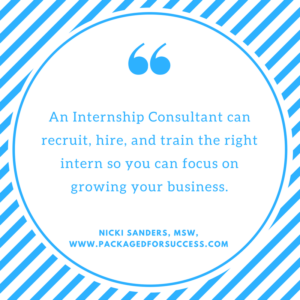How can employers attract the best interns?
Culture, development and authentic experiences all play their part
Across the nation, internships are on the rise. According to the National Association of Colleges and Employers’ 2017 Internship & Co-op Survey, employers are planning to hire 3.4% more interns this year than they did last year.
This is great news for the millions who look to internships for valuable career skills and college credits, as well as future job opportunities. For employers, it’s more important than ever to connect with the best candidates who represent the future talent of their organizations.
Attracting the best applicants
In a recent survey, Collegefeed asked 15,000 millennials (60% were in college and 40% had graduated) about what they considered when choosing internships and future employers. The top 3 responses (in order) were: people and culture fit, career potential and work-life balance. Compensation came in fourth. How do candidates find out about these aspects? Mostly thorough friends, job boards and on-campus visits.
Culture
It’s important to note that while the current pool of millennial and Gen Z interns prioritize culture, that’s not a shift from previous generations, according to David Shanklin, Head of Culture Strategy at CultureIQ.
Previous generations wanted a good experience in an internship, too, Shanlkin told HR Dive. Candidates today are just more vocal about it.
“We know this because in employee engagement conversations, we are a lot more aware of culture as a core value of younger candidates,” he said. “Millennials want and need to align their values with those of the organizations they intern for.”
Personal development
Nikki Schlecker of WayUp, says that what most interns want is a chance to learn and grow. Schlecker is Head of People for the platform, which helps early-career professionals explore opportunities and learn about and connect with employers.
“Interns are new to the workforce, and their time at a company might be their first major exposure to the professional world,” she said. “At the end of the day, perks and brand reputation are great, but it’s the learning and growth opportunities that matter most.”
And attracting interns requires a deeper understanding of what this takes. “When recruiting potential hires, it is vital to highlight these opportunities — which can include things like a mentorship program, weekly trainings, and what a clear path to success looks like at the company,” she explained. “So, when building your program, make sure to put in the extra effort at the beginning to ensure there is a clear plan to provide development and learning opportunities.”
Virginia White, Head of People Operations at 3D printing company Formlabs, offered similar advice. As a startup, the company converted 50% of its interns to regular employees over the course of just two years — resulting in one of the most productive and profitable periods in the company’s early history.
White attributes a lot of that success to the real work interns were permitted to pursue.
“When we were smaller, interns were a huge part of our organization,” she said. “Part of that was necessity, because small companies need to be flexible, hiring interns is low-barrier and low-risk, and we weren’t yet sure how successful our product would be.”
“We found that interns would contribute just as much as FTEs, because they were in a growth-mindset, had a hunger to learn, and were on a deadline,” White said. “We also found that most interns didn’t come in with a lot of ‘pre-set’ ideas about ‘how a company should work’ because they hadn’t had a lot of experience.”
Authentic work-life balance experiences
Internships also need to reflect what an authentic career will be like at an organization, Shanklin said. For example, employers should put interns through the same onboarding process as regular, full-time employees. They should experience all of the day-to-day aspects of an employer’s jobs, including work-life balance aspects.
A lot of this comes back to branding. Eighty-four percent of the 300 employers that Collegefeed interviewed said that they understand hiring and offering internships to college students is important, yet 92% admitted to struggling with presenting the right brand to candidates. Many find it challenging to be noticed among large companies with strong brands and cultures.
Putting it into practice
HR Dive asked our experts: “How can companies leverage their strengths to attract the best interns this year?”
“Every company is different, as is every intern,” Schlecker said. “You need to understand what your values are, and then recruit top intern talent that shares those values.”
One of WayUp’s core values is “be a master of your craft, but know you’re not the master.”
“By recruiting interns that embody this value from the start, we are able to recruit the best talent for our company’s specific culture,” Schlecker explained. “Make sure to define these values and put them front and center in the job posting. Be explicit about it. Your future interns will be happy that you know who you’re for and who you’re not for.”
Shanklin suggests that employers create concrete development opportunities for interns, because they have such a short period of time to make a big impact. “Multiple touch points with managers, mentors, and peers are critical to cement this development,” he said. “Make sure that the internship is clearly defined and that clear expectations around all roles are set right away.”
White recommends proactive advertising efforts. “We put a lot of energy into promoting the internship program both by speaking, reaching out proactively, and sponsoring events,” she said.
Rolling internships throughout the year also seem to suit FormLabs. “[W]e often keep our internships open all year long, so we constantly get a stream of people coming in,” she said. “Posting on job boards is fine, but we really find the great people through referrals from peers, professors at schools and other recent alumni.”
Article originally appeared on HR Drive.
